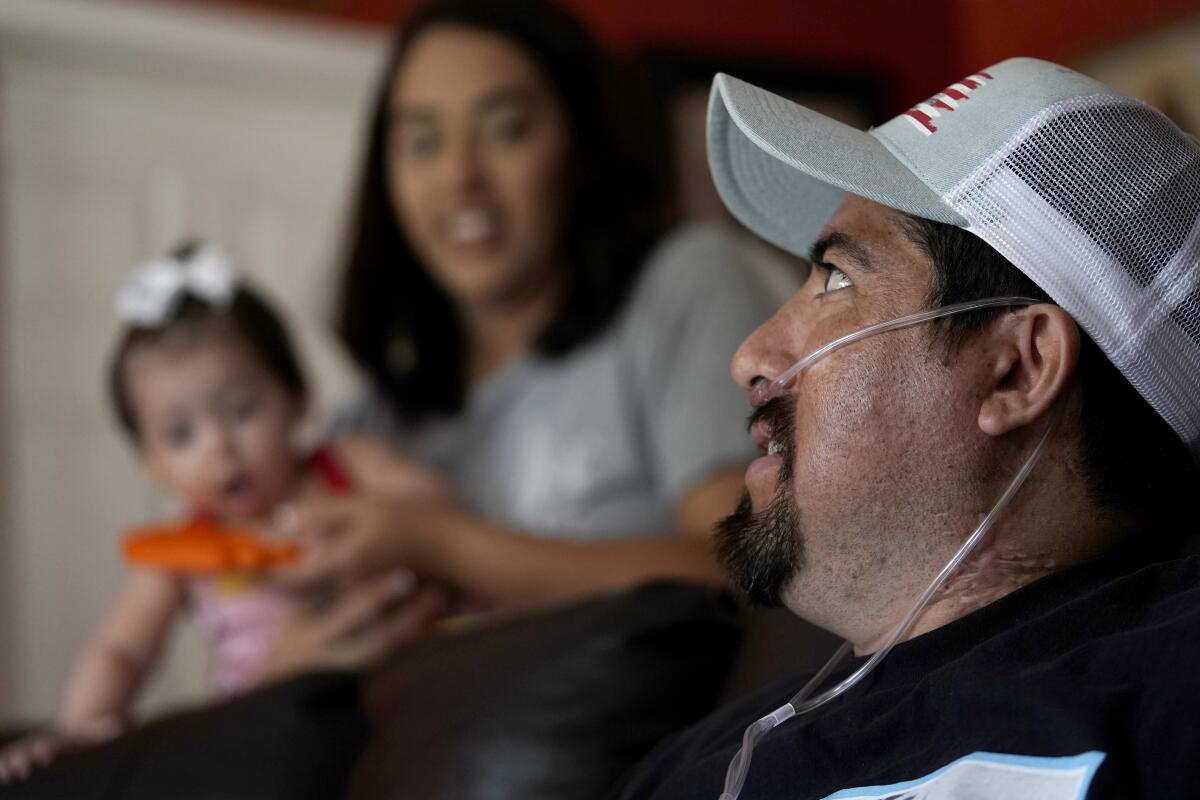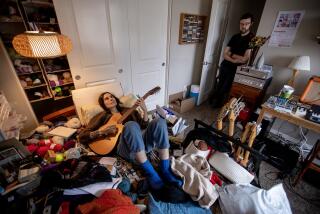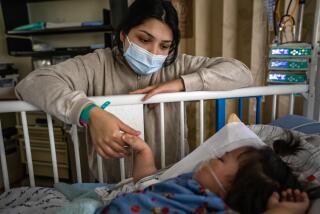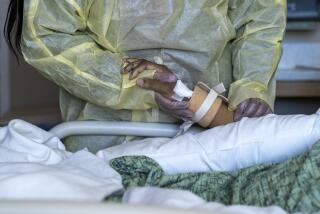Scars of COVID persist for sickest survivors, families

Freddy Fernandez almost wasn’t here, on his couch in his Missouri home, his baby on his lap gnawing on the pulse oximeter he uses to check his oxygen levels after a months-long bout with COVID-19.
The 41-year-old father of six spent five months hospitalized a four-hour drive away from the family’s home in the southwest Missouri town of Carthage on the most intense life support available. He nearly died repeatedly and now he — like so many who survived COVID-19 hospitalizations — has returned home changed.
While more than 1 million have died of COVID across the U.S., many more have survived intensive care unit stays that have left them with anxiety, PTSD and a host of other health issues. Research has shown that intensive therapy starting in the ICU can help, but it was often hard to provide as hospitals teemed with patients.
“There is a human cost that the patient pays for ICU survivorship,” says Dr. Vinaya Sermadevi, who helped care for Fernandez throughout his stay at Mercy Hospital St. Louis. “It is almost like going to war and having the aftermath.”
Fernandez’s memories from those long months come in snatches — moments when he regained consciousness, hooked up to machines to breathe for him, clinging to life. Sometimes he asked for his mother, who died of COVID-19 in September 2020.
He missed the birth of his daughter and the first four months of her life. He may never be able to return to his construction job. His other young daughter is terrified he’ll go away again.
His partner, Vanessa Cruz, 28, was still pregnant with Mariana last summer when the Delta variant struck. She got vaccinated at the urging of her obstetrician. Fernandez, too, was warming up to the idea of the vaccine in late August, but it was too late. He had come down with COVID.
The native of Mexico City, who came to the U.S. around 20 years ago to work construction, was so sick he ended up at the St. Louis hospital, nearly 270 miles away from his two young daughters; Cruz’s 10-year-old son, Miguel, who considers Fernandez his father; and three other children with his ex-wife — 10-, 8- and 7-year-old boys.
It was a dark period when many people hoped the pandemic was ending, but the Delta variant once again flooded the healthcare system. Filling shifts was a daily battle, and death was everywhere, recalled Sermadevi.
In some ways Fernandez was lucky. For all the talk of ventilator capacity, what was in shortest supply during the Delta surge was something called ECMO, or extracorporeal membrane oxygenation. It is used when a ventilator isn’t enough, pumping blood out of the body, oxygenating it and then returning it.
Mercy Hospital St. Louis only had the equipment and staff to care for three ECMO patients at a time. And on Sept. 3, Fernandez became one of them.
Cruz delivered Mariana on Oct 13.
Far away from her fiancé, Cruz logged into video calls with Fernandez’s doctors on the very day she brought the newborn home. The news wasn’t good — Fernandez was suffering from infections and wasn’t recovering well.
A lung transplant, Sermadevi said, appeared to be his best option, but was a long shot.
“And there is a chance that Mariana might grow up without a father,” Sermadevi recalls telling the family.
Some of the most important keys to recovery in critical care aren’t medical. Visits from relatives, along with physical, occupational and speech therapists, have long been shown to make a difference for the sickest of patients.
COVID-19 upended those practices at many hospitals, as families were kept away to keep the virus from spreading.
Fears of infection, plus short staffing, also often meant less physical therapy, which has proved to speed recovery.
When Fernandez’s family came, it had a positive effect.
His room was transformed, photos of his family thumbtacked to the ceiling. Fernandez’s family held his hand when he had respiratory distress, talking him through it. He needed less sedation and pain medication because, Sermadevi said, “they were that for him.”
“We would just hear such love at the bedside,” she said.
Once he came off the ECMO machine, Fernandez started to recover. With his lungs slowly improving, soon he was up and trying to walk. Ultimately, lung transplant talk was tabled.
By Feb. 9, he was heading home, 167 days after he first arrived at the hospital in his hometown.
All Cruz could think was “finally.” Fernandez had never met his baby. Nor had he seen any of his other children. Their interactions had been limited to Facetime and pictures.
Melanii was shy, hugging him briefly along with older brother Miguel, before clinging to her mother.
Cruz kissed the baby and then laid her in Fernandez’s arms. Just days away from turning 4 months old, Mariana smiled at him.
Fernandez relied on a walker and a wheelchair at first. He couldn’t sit or eat on his own.
But now the wheelchair is abandoned on the home’s back steps. He can walk around the entire block, pulling a portable oxygen canister behind him on a dolly. He’s on the cusp of being able to carry his oxygen around in a backpack, which would give him more freedom.
Cruz is returning to work, life returning “back to normal a little bit.”
They want to wait until Fernandez gets better to get married.
Yet they don’t know how much better he will get — or how quickly.
Such is the story of so many, who are alive yet forever changed, says Sermadevi, who has followed his progress from afar. Some of the nurses even became Facebook friends with Cruz.
“It’s sad and happy at the same time,” she acknowledges. “And that’s very hard to reconcile.”
More to Read
Sign up for Essential California
The most important California stories and recommendations in your inbox every morning.
You may occasionally receive promotional content from the Los Angeles Times.










